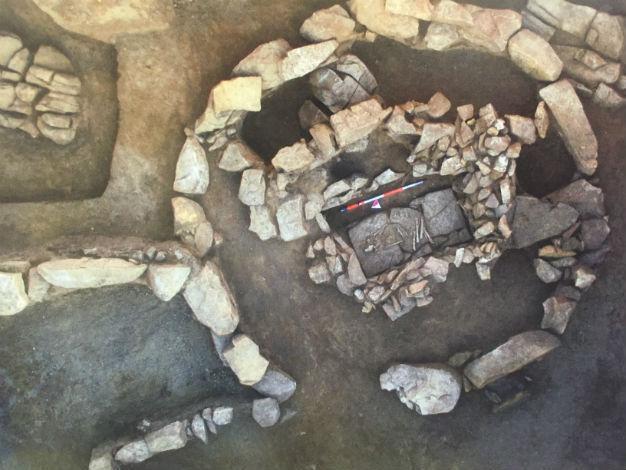Tomb in Istanbul's Silivri year’s ‘biggest archaeological discovery’
Ömer Erbil - ISTANBUL
 Excavations by the Istanbul Archaeology Museum in Istanbul’s Silivri district have unearthed a “kurgan-style” tomb, which officials have already heralded as the biggest archaeological discovery of the year.
Excavations by the Istanbul Archaeology Museum in Istanbul’s Silivri district have unearthed a “kurgan-style” tomb, which officials have already heralded as the biggest archaeological discovery of the year. A kurgan is a circular burial mound constructed over a pit grave that often contains grave vessels, weapons and the bodies of horses as well as a single human body. The type of tomb was originally used on the Russian steppes but later spread to eastern, central and northern Europe in the 3rd millennium B.C. The type of grave was holy in Turkic and Altay culture.
The skeleton of a person who was believed to have been an important warrior was found inside the tomb alongside an arrowhead.
The tomb is “the first and oldest 5,000-year-old kurgan-style tomb that has been discovered and completely unearthed in Turkey,” according to the excavation report, which is expected to provide new information about the history of Istanbul and Thrace in the wake of the Yenikapı archaeological excavations.
The excavations have been carried out on the site of summer houses where social facilities will be established in Silivri’s Çanta village. Initiated in December 2015, the excavations lasted five months.
According to a report sent to the Istanbul Cultural and Natural Heritage Preservation Board, the soldier inside the tomb is believed to have lived in the Bronze Age. It is reported that the kurgan-style tomb, the forerunner of the tumulus, was previously looted by treasure hunters who nonetheless failed to access the main tomb.
Oldest kurgan in Turkey
Kurgan-style tombs were prominent in Central Asian culture. The same type of tomb was found in pieces in 1980 by Professor Mehmet Özdoğan in the Taşlıcabayır field in the northwestern province of Kırklareli’s Asılbeyli village during surface surveys of Thrace.
Further excavations have failed to unearth the architectural structure, but earthenware pots from the Iron Age in 1,200 B.C. have been found.
The grave was the only known kurgan-style tomb in Thrace until the discovery of the tomb in Silivri, which not only older than the Kırklareli find but also completely intact.
The Istanbul Archaeology Museum has requested the registration of the tomb’s field and transfer of the tomb to a museum with its all pieces. The museum will display the tomb in its Thrace and Istanbul findings section.
“Thrace received migrations from the north. This is a kurgan-style tomb and such tombs exist in my studies, too,” said Istanbul University Archaeology Department Prehistoric Department Professor Mehmet Özdoğan. “I know that lots of kurgan tombs have been destroyed in Thrace. We have rescued one of them from the digger. But this tomb is older and is from the Bronze Age. It is a very important discovery. I believe scientific examinations will lead to interesting results.”
Buried in hocker position
The circular tomb, which is surrounded by stones in a plan, is six meters in width. The inside of the tomb, however, is in a rectangular shape.
The skeleton lies on stony ground in a half-hocker position and is buried with gifts for the dead. The hocker position is a fetal-like position where the arms embrace the lower limbs, ostensibly to allow the deceased to enter the next world like a newborn or to prevent the dead from rising from the grave.
The arrowhead on the skeleton symbolizes that he was an important warrior or commander.
Two earthenware pots from the Bronze Age that were also found in the tomb were believed to be gifts to the deceased.
















